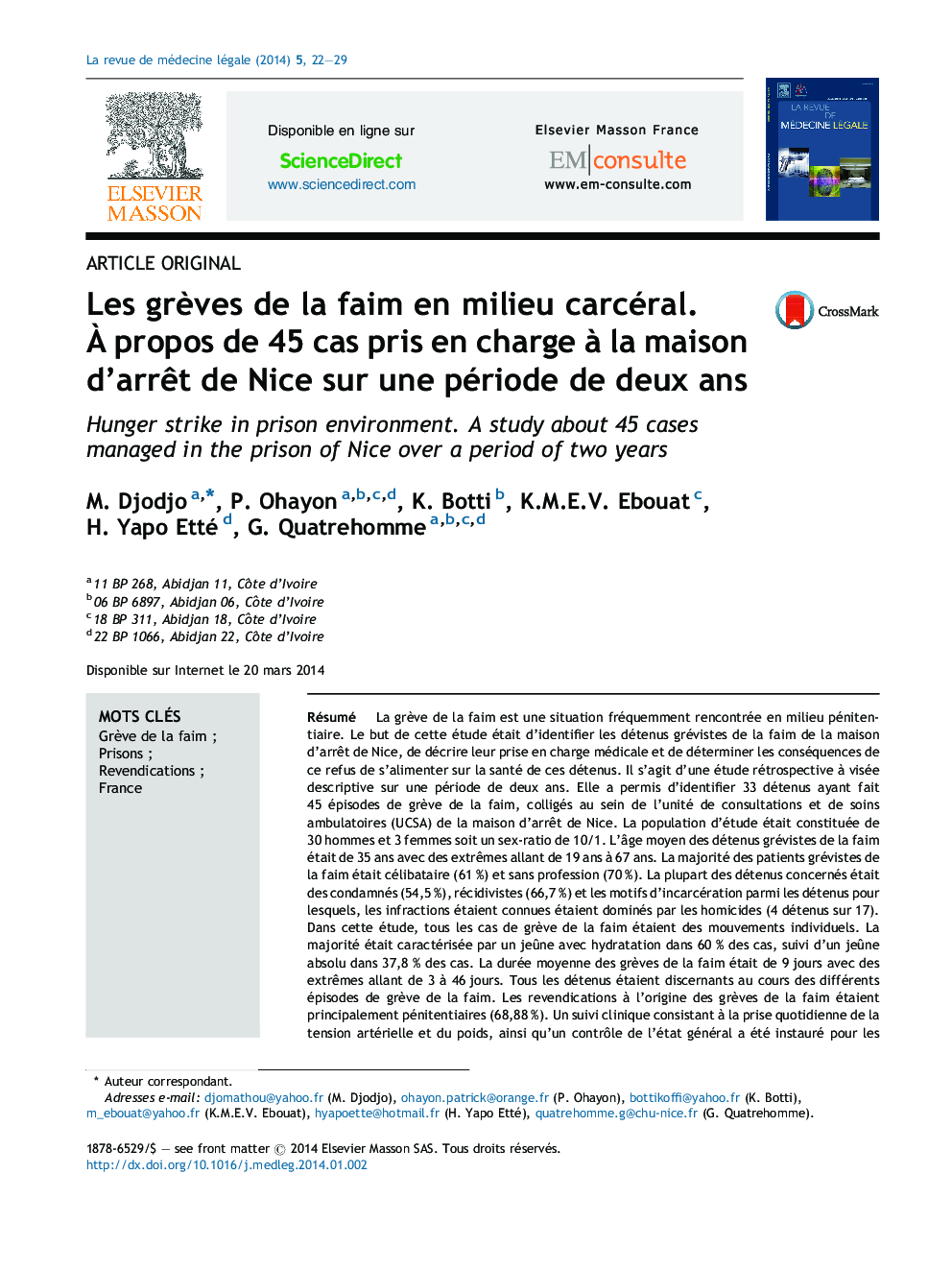| کد مقاله | کد نشریه | سال انتشار | مقاله انگلیسی | نسخه تمام متن |
|---|---|---|---|---|
| 1098436 | 952977 | 2014 | 8 صفحه PDF | دانلود رایگان |
عنوان انگلیسی مقاله ISI
Les grèves de la faim en milieu carcéral. à propos de 45 cas pris en charge à la maison d'arrêt de Nice sur une période de deux ans
دانلود مقاله + سفارش ترجمه
دانلود مقاله ISI انگلیسی
رایگان برای ایرانیان
کلمات کلیدی
موضوعات مرتبط
علوم زیستی و بیوفناوری
بیوشیمی، ژنتیک و زیست شناسی مولکولی
ژنتیک
پیش نمایش صفحه اول مقاله

چکیده انگلیسی
Hunger strike is a situation frequently encountered in jail. The aim of this study was to identify detainees on hunger strike in prison in Nice, describe their medical care and determine the consequences of this refusal to feed on the health of the prisoners. This is a descriptive retrospective study carried out over a period of two years. It helped identify 33 inmates who went through 45 periods of hunger strike, collected within the consultation and ambulatory care Unit of the prison in Nice. The study population consisted of 30 men and 3 women with a sex ratio of 10/1. The average age of inmates on hunger strike was 35 years, with extremes ranging from 19 to 67 year. The majority of patients hunger strikers were single (61%) and jobless (70%). Most of the prisoners concerned were convicted (54.5%), recidivists (66.7%) and reasons for incarceration were dominated by homicides (12.1%). In this study, all cases of hunger strike were represented by individual movements. The majority was characterized by fasting with hydration in 60% of cases, followed by absolute fasting in 37.8% of cases. The average duration of the hunger strikes was 9 days, with extremes ranging from 3 to 46 days. All detainees were aware of what they were doing during the different periods of hunger strike. Claims that led to hunger strikes were mainly of jail condition origin (68.88%). A clinical follow-up consisting of the daily survey of blood pressure and weight, as well as a control of the general condition was introduced for prisoners. A weekly blood check up with hematological and biochemical purpose was performed in 10 cases (22.2%). No organic complication was detected in detainees at the end of each episode of hunger strike. In the majority of cases (66.66%), the weight of the prisoner hunger striker either increased (24.44%) or was stable (42.22%) at the end of the episode of hunger strike. However, in 12 cases (26.64%), there was a weight loss of about 5.3% (that is 4.55Â kg) over 17 days of hunger strike, on average. The weight change of prisoners on hunger strike suggests that most of the hunger strikes in prisons are ways of claiming that do not put the prisoner's life in danger. However, this observation should in no way alter the vigilance and modify the therapeutic and ethical attitude of doctors before a detainee on hunger strike.
ناشر
Database: Elsevier - ScienceDirect (ساینس دایرکت)
Journal: La Revue de Médecine Légale - Volume 5, Issue 1, March 2014, Pages 22-29
Journal: La Revue de Médecine Légale - Volume 5, Issue 1, March 2014, Pages 22-29
نویسندگان
M. Djodjo, P. Ohayon, K. Botti, K.M.E.V. Ebouat, H. Yapo Etté, G. Quatrehomme,